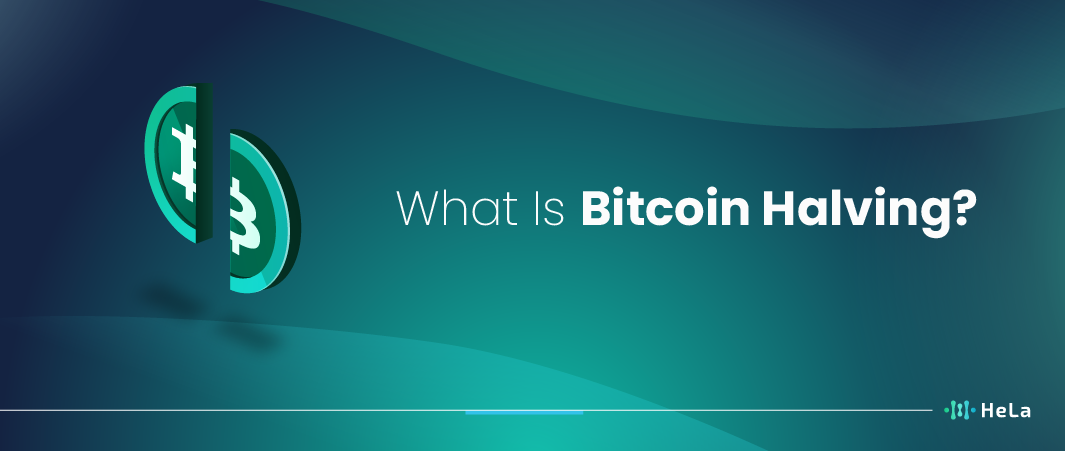Within the booming cryptocurrency space, Bitcoin is the most well-known and trailblazing digital money. A fascinating feature of its architecture is the Bitcoin halving, a predetermined occurrence that occurs around every four years. In any case, what absolutely is this occasion, and why is it pulling so much intrigue within the cryptocurrency community?
By portraying its workings and the repercussions it has on the advertisement, this piece looks to demystify the thought of Bitcoin halving. However, what exactly is this occasion, and why is it attracting so much intrigue within the cryptocurrency community? By depicting its workings and the repercussions it has on the showcase, this piece looks to demystify the thought of Bitcoin dividing.
A predetermined set of guidelines was built into the programming when Bitcoin was first formed. Because of these regulations, there will only ever be a limited quantity of Bitcoins, simulating the scarcity of valuable materials like gold. The halving event is instrumental in upholding this rule, having profound implications on Bitcoin miners and investors alike.
The halving reduces the rewards miners receive for verifying and adding new transactions to the blockchain. This not only impacts miners’ revenues but also has been historically linked to significant market movements. Join us as we journey through the intricacies of this event and its broader consequences.
What Is Bitcoin Halving?

The halving of Bitcoin, often known as the “halvening,” is a significant development in the cryptocurrency space, particularly for Bitcoin. The incentives that miners gain for safeguarding the Bitcoin network by appending new blocks to the blockchain are systematically and preprogrammedly reduced. Here’s a more thorough breakdown of the Bitcoin halving mechanism:
Bitcoin’s Block Reward
When Satoshi Nakamoto, an unnamed person, invented Bitcoin, the intended quantity was set at 21 million coins.To issue new bitcoins into circulation, a process called mining was established. Miners solve complex mathematical puzzles, and when they successfully add a new block of transactions to the blockchain, they are rewarded with bitcoins. Initially, the reward was 50 bitcoins per block.
Halving Events
To control the inflation of Bitcoin and gradually release new coins, Bitcoin’s protocol includes a halving event roughly every four years (specifically, every 210,000 blocks). During a halving, the number of new bitcoins created and awarded to miners is cut in half. The first halving occurred in November 2012, reducing the reward from 50 to 25 bitcoins. The second halving occurred in July 2016, reducing it to 12.5 bitcoins. The third halving took place in May 2020, further reducing the reward to 6.25 bitcoins.
Also Read: Layer 1 vs Layer 0: Decoding Blockchain Layers
Impact on Supply
These halving events have a significant impact on the supply of new bitcoins entering circulation. They create scarcity in the cryptocurrency, which can potentially affect its value. As the rate of new supply decreases, Bitcoin becomes increasingly deflationary, and this scarcity is often seen as a key feature contributing to its store of value and investment appeal.
Miner Incentives
Bitcoin halving events also affect the incentives for miners. Miners are forced to depend more on transaction fees to sustain their income when the block reward is decreased. This may result in more miners competing with one another and in enhanced network efficiency and security.
Historical Price Movements
Previous Bitcoin halving events have been associated with significant price rallies. Speculative trading and investing are frequently prompted by the halving event’s heightened awareness and the limited supply of new coins. It’s crucial to remember that past success does not guarantee future outcomes, and the bitcoin market is very erratic.
Anyone working in the cryptocurrency field has to understand how Bitcoin halving works because it has a significant impact on the ecology, value, and mining activity of the cryptocurrency. It’s a feature of the Bitcoin protocol that was included to control its monetary policy and has attracted a lot of interest from researchers, enthusiasts, and investors.
Historical Market Reactions to Bitcoin Halving
Historically, Bitcoin halvings have been associated with significant market movements. The months driving up to and taking after the splitting occasions have frequently seen an uptick in Bitcoin’s cost. This is often not a coincidence.
The reduced block reward means that fewer new Bitcoins are entering circulation. If demand remains constant or increases, this reduction in supply can create upward pressure on the price. This has led many to view the halving events as bullish indicators for Bitcoin.
However, it’s essential to note that numerous other factors influence the crypto market. Although halvings and price spikes have historically correlated, correlation does not prove causality. The direction of the market is greatly influenced by external variables like changes in regulations and the state of the world economy.
Implications for Miners Bitcoin

The halving of Bitcoin is a phenomenon that takes place in the Bitcoin network roughly every four years. Miners get paid 50% less for validating transactions and uploading them to the blockchain during a halving. Here’s some additional context and the implications for miners:
Reduced Rewards
The most immediate implication for miners is a reduction in their block rewards. Before a halving, miners receive 12.5 BTC per block, which is then halved to 6.25 BTC after the event. This means miners will earn less for their efforts, and it can impact their profitability.
Increased Competition
With reduced rewards, mining becomes less profitable, and this can lead to increased competition among miners. Miners will need to have more efficient hardware and lower operational costs to remain competitive in the reduced reward environment.
Miners’ Revenue
To compensate for the reduced block rewards, miners rely on transaction fees. As Bitcoin’s popularity and adoption grow, transaction fees become a more significant portion of miners’ revenue. Miners may need to prioritize transactions with higher fees to maximize their earnings.
Halving Schedule
The Bitcoin halving event is predictable and occurs every 210,000 blocks, which is approximately every four years. Miners can plan for this event and adjust their strategies and expenses accordingly.
Network Security
The Bitcoin halving is designed to control inflation and maintain the scarcity of the cryptocurrency. While reduced rewards can be challenging for miners, it also ensures that the network remains secure and that Bitcoin retains its value.
Long-Term Perspective
Long-term financial specialists can see Bitcoin halvings as an implies of protecting both the esteem of their property and the network’s common wellbeing. The reduced supply resulting from halving events can contribute to Bitcoin’s price appreciation.
Mining Centralization
The halving can also contribute to mining centralization. Larger mining operations with better resources are more likely to survive the reduced block rewards, while smaller miners may be forced out of the market.
Economic Considerations
Miners need to carefully manage their operating costs, electricity expenses, and hardware investments to remain profitable. They may need to upgrade their mining equipment to stay competitive.
Market Speculation
Bitcoin halvings are often accompanied by increased media attention and speculation about their impact on the price of Bitcoin. Miners may need to navigate market volatility and uncertainty.
Long-Term Impact on the Bitcoin Ecosystem
Financial specialists, specialists, and cryptocurrency aficionados are all exceptionally curious about and debating the long-term impacts on the Bitcoin biological system. Since its creation in 2009 by an unidentified individual going by the title Satoshi Nakamoto, Bitcoin has experienced gigantic change, and its impact on the world’s budgetary framework is as it were getting to be more grounded. When talking around the long-term impacts on the Bitcoin environment, it’s important to require the taking after under consideration:
Price and Market Adoption
Since its dispatch, there has been a discernible increment in both the cost and advertise acknowledgment of bitcoin. The cost of the cryptocurrency has changed incredibly all through its numerous bull and bear markets. Long-term speculators have seen noteworthy returns on their capital, but a few depreciators claim that Bitcoin’s cost instability limits its capacity to operate as a solid store of esteem.
Digital Gold
Because of its finite supply of 21 million coins and its usage as a hedge against inflation and economic uncertainty, Bitcoin is sometimes referred to as “digital gold“. Like gold, some financial specialists see Bitcoin as a resource that can be utilized as a secure safe house and long-term store of esteem. It’s conceivable that organizations like central banks, support stores, and enterprises may proceed to utilize it as an advanced save resource within the future.
Blockchain Technology
Thousands of extra cryptocurrencies and blockchain activities have been created much obliged to the foundational blockchain innovation of Bitcoin. The thought of decentralized, peer-to-peer advanced cash was to begin with, popularized by Bitcoin, which has had a colossal effect on the bigger blockchain biological system. Blockchain technology’s rise has repercussions for a number of businesses, counting supply chains, healthcare, and managing an account.
Regulatory Environment
Regulating cryptocurrencies like Bitcoin remains a challenge for governments and regulatory agencies worldwide. The long-term regulatory environment surrounding Bitcoin has the potential to greatly impact its use and acceptance. While some nations have welcomed it, others have put severe restrictions or outright bans on it.
Financial Inclusion
By giving the unbanked and underbanked populaces access to money related administrations, Bitcoin has the potential to extend budgetary incorporation. Within the long run, it may have a noteworthy impact on worldwide settlements, cross-border installments, and the accessibility of budgetary rebelliousness in underprivileged ranges.
Technological Advancements
Numerous innovative developments have been made within the Bitcoin environment, such as the creation of second-layer arrangements just like the Lightning Organize, which are expected to extend versatility and lower exchange costs. These advancements may be greatly imperative to Bitcoin’s long-term survival and take-up.
Environmental Concerns
Attention has been drawn to Bitcoin’s energy usage and environmental effects. An increasing number of people are pushing for the creation of energy-efficient consensus algorithms and more ecologically friendly mining techniques as the ecosystem develops.
Security and Custody
The long-term success of Bitcoin also depends on the continued improvement of security measures and custody solutions. Investors and institutions require robust security infrastructure to safeguard their Bitcoin holdings.
Global Economic Events
The performance and influence of Bitcoin are strongly correlated with world economic events, including monetary policy choices, economic crises, and inflation. Its long-term function as a buffer against these developments will depend on how they play out.
Also Read: What are Crypto Whitepaper and Litepaper? Key Elements and Differences
Community and Developer Engagement
An engaged and enthusiastic community of developers, users, and supporters is essential to the Bitcoin ecosystem. The community’s dedication to upholding and enhancing the network is essential to its sustained prosperity.
The address of Bitcoin’s long-term impacts on the worldwide money related framework is complicated and always changing. Indeed, whereas Bitcoin has picked up a part of reputation and footing, its future course will be decided by a number of factors, such as changes in laws and controls, mechanical breakthroughs, and its capacity to handle worldwide budgetary troubles. Partners and financial specialists are still keeping a cautious eye on these factors to gauge Bitcoin’s long-term supportability and effect.
Halvings and Public Perception

Bitcoin halvings have a significant impact on how the public sees and embraces this digital currency. These events grab the attention of mainstream media, resulting in more people learning about Bitcoin and possibly deciding to get involved. Each Bitcoin halving serves as a vivid reminder of the cryptocurrency‘s unique economic structure, which differs greatly from traditional financial systems.
The concept of scarcity associated with Bitcoin, accentuated by its halving events, often piques the interest of new investors. As more folks discover and invest in Bitcoin, its role in the broader financial landscape becomes more solid. This increased recognition can potentially lead to more widespread adoption and the integration of Bitcoin into traditional markets. In essence, Bitcoin halvings act as pivotal moments in the cryptocurrency’s journey, drawing the spotlight and encouraging people to explore the world of digital finance.
Conclusion
Bitcoin halving, while a technical aspect of the cryptocurrency’s design, has broader implications that ripple through the entire crypto ecosystem. From miners evaluating their profitability to traders speculating on post-halving price movements, this event remains one of the most anticipated in the crypto calendar.
The genius of Bitcoin’s design is evident in how the halving mechanism upholds its scarcity principle, ensuring its distinction from traditional fiat currencies. As we inch closer to the maximum supply of 21 million Bitcoins, the world watches with bated breath to witness the evolution of this digital marvel.
In the ever-evolving landscape of cryptocurrencies, one thing remains clear: Bitcoin and its halving events will continue to shape the discourse, market dynamics, and public perception of digital assets for years to come.
Disclaimer: The information provided by HeLa Labs in this article is intended for general informational purposes and does not reflect the company’s opinion. It is not intended as investment advice or recommendations. Readers are strongly advised to conduct their own thorough research and consult with a qualified financial advisor before making any financial decisions.

Joshua Soriano
I am a writer specializing in decentralized systems, digital assets, and Web3 innovation. I develop research-driven explainers, case studies, and thought leadership that connect blockchain infrastructure, smart contract design, and tokenization models to real-world outcomes.
My work focuses on translating complex technical concepts into clear, actionable narratives for builders, businesses, and investors, highlighting transparency, security, and operational efficiency. Each piece blends primary-source research, protocol documentation, and practitioner insights to surface what matters for adoption and risk reduction, helping teams make informed decisions with precise, accessible content.
- Joshua Soriano#molongui-disabled-link
- Joshua Soriano#molongui-disabled-link
- Joshua Soriano#molongui-disabled-link
- Joshua Soriano#molongui-disabled-link

